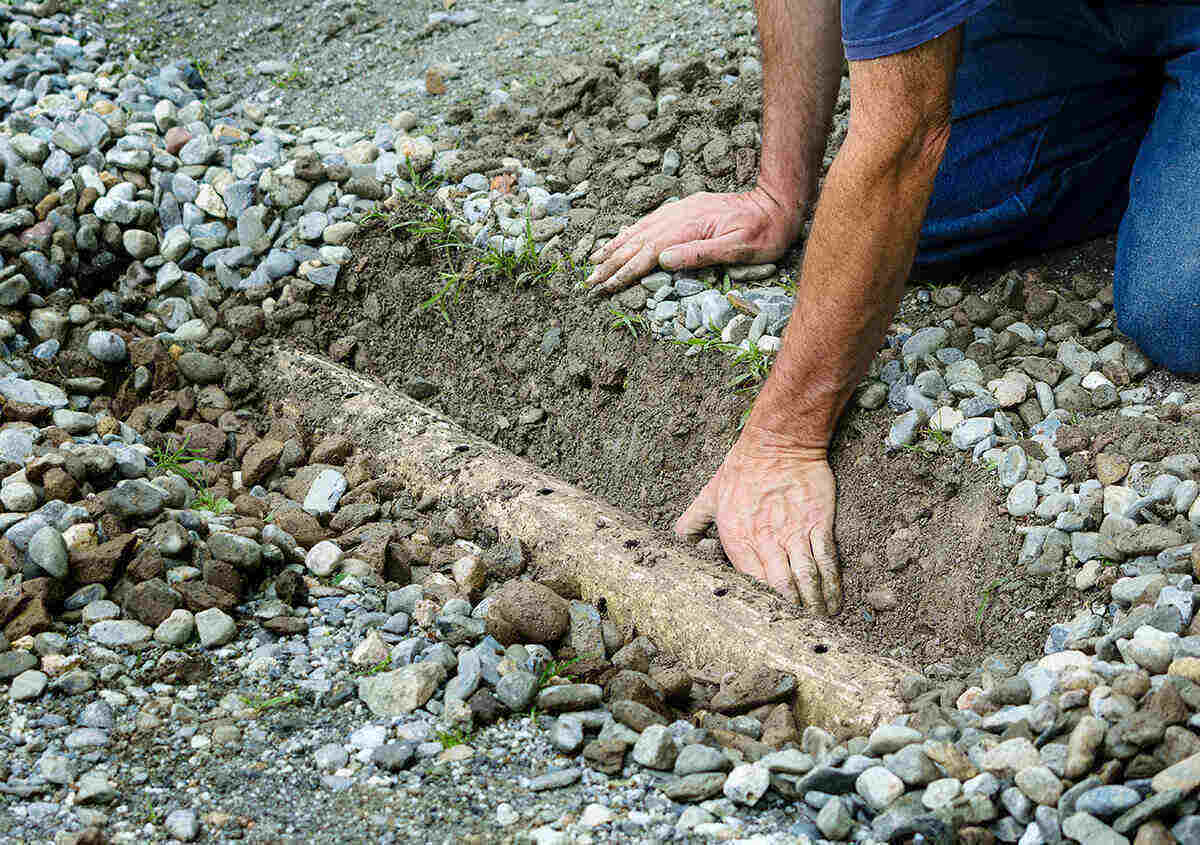
Water standing in your yard? That’s almost always a sign of poor drainage, especially if it lasts more than a day. Compacted soil, low spots in the landscape, or clogged gutters might be the culprit of your drainage woes. Or, the source might stream from your neighbor’s yard. Let’s look at seven ways to improve drainage in your yard.
1. Build up Low Spots
Areas of your yard may have low spots or sunken areas that hold water and are slow to drain. Mound organic material, such as topsoil mixed with compost or rotted manure, over the low areas in your landscape. Add enough to create a slight rise compared to the surrounding soil level. If standing water returns to the area, repeat these steps a time or two.
Once the low spot has been stabilized, sow grass seed. Cover with straw, row cover, or other lightweight material to protect the seed from being devoured by birds. Remove when grass seed sprouts.
If a low spot continues to develop, consider consulting a landscape professional to assess the problem.
2. Aerate the Lawn
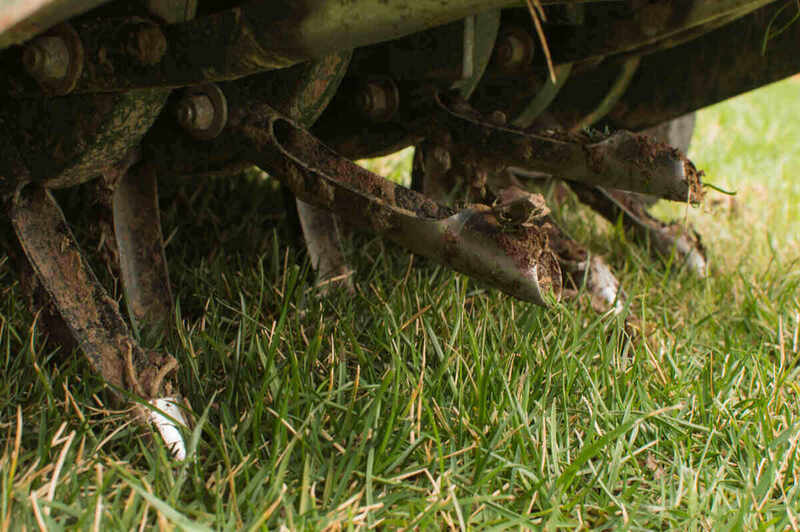
An aerator pulls plugs of soil from the ground to help relieve soil compaction. The plugs look similar to dog doo-doo, but they’ll decompose after a couple of weeks. The aeration results in holes opening up the soil to allow for water, oxygen, and nutrients to reach the grass roots.
Aeration is an important improvement, especially when the soil is compacted from people walking or playing on the lawn. Compacted soil cannot absorb water well.
Poor drainage in your garden beds? Wood mulch and compost also can become compacted by rain and repel water, causing runoff. To correct this problem, use a rake to loosen up the mulch or compost, which will help with water absorption.
3. Install a French Drain
The magic of a French drain is all underground. Sometimes called channel drains, trenches are dug up to 2 feet deep and lined with gravel. A perforated pipe is placed on the gravel, and the trench is backfilled and covered with soil or stones.
The location of a French drain is critical because drainage needs to flow away in a downward fashion by gravity. Building a French drain is an advanced DIY job for the homeowner. There’s some engineering involved in determining slope, depth of the drain pipe and other measurements. You may want to hire a landscape company to do this job.
4. Build a Rain Garden
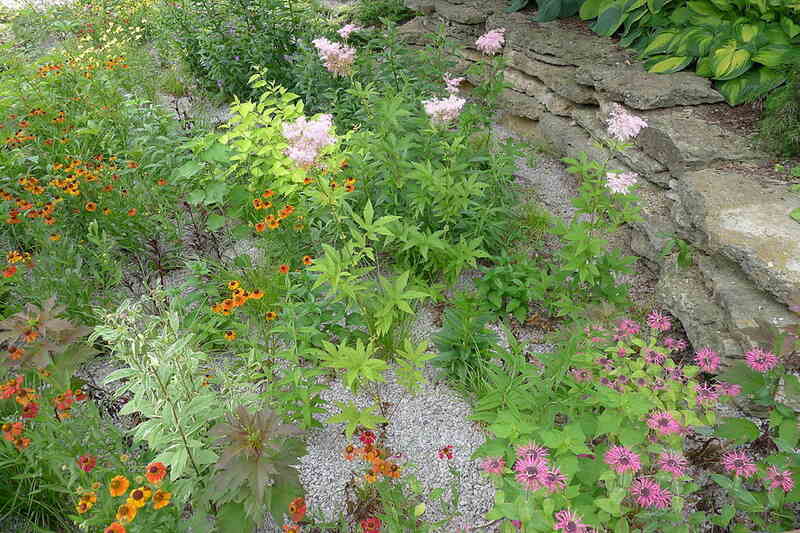
Several water-loving plants do well in rain gardens, where the perennials, shrubs, and trees tolerate wet and dry conditions. The plants absorb the water and slow it down as it moves through the garden. Rain gardens allow water to seep into the soil.
A rain garden is more than plopping in plants where the ground stays wet. There’s excavating 2 or 3 feet of soil, leveling the base, building a berm and a catch basin for overflow. Rain gardens filter water, absorb it and distribute it along its pathway, usually within 48 hours.
Although rain gardens, swales, and dry creek beds seem like similar ways to control drainage problems, they have their differences, especially in application. DIYers may be able to create each of these, but if drainage is terrible and standing water is common, it may be time to call a pro. An expert will study how soil moves or retains water, the grade of the land, and other aspects to make recommendations.
5. Create a Swale
‘Swale’ is a $100 word for a drainage ditch, or sunken, marshy area or other slope on the property. Swales frequently run parallel to the road, especially in suburban and rural areas. Others form between properties where the land slopes.
Sometimes plants, stones or boulders are arranged in the swale to direct water slowly away from the property, so it doesn’t wash out landscape soil. Cattails are popular for swales but plant only the native broad-leaved cattail (Typha latifolia).
Some swales may need to be cleaned out periodically or they will get backed up and flood your property. A critical area for clean out is the culvert that runs under paved surfaces, such as a driveway, where debris can build up.
6. Add a Dry Creek Bed
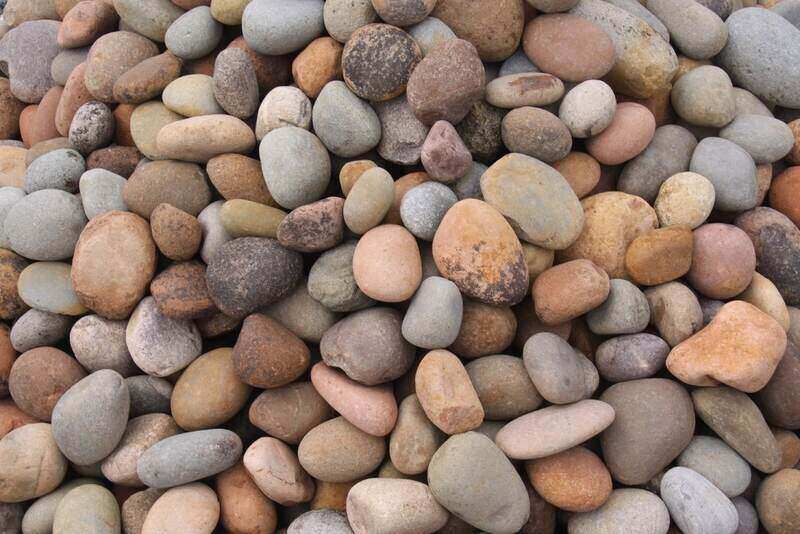
As the name implies, a dry creek bed becomes a creek when it rains. A dry creek bed, also called an arroyo, is a shallow trench filled with stone, such as river rock. It is designed to move water quickly, yet controlled by how it flows amid the rocks.
Dry creek beds allow water to move through the landscape without washing out soil. The water flows to a drainage area, such as a swale or catch basin. Plant perennials or shrubs at the edges of the bed but not directly in the bed.
7. Clean Gutters and Add Downspouts
House gutters full of leaves and other debris cause them to overflow, which can cause leaking at the foundation. Remove the debris from your clogged gutters or hire a pro to handle the job for you.
Attach a vinyl extender drainage pipe to downspouts to drain water to a better area. Or, if possible, bury the extender to distribute the water underground.
Why is Improving Drainage Necessary?
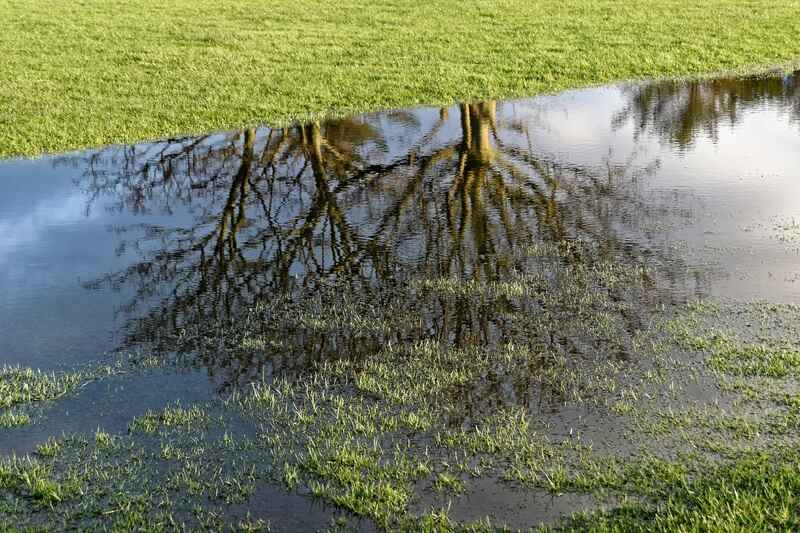
Water that sticks around too long can cause all kinds of problems, from structural weakening to a habitat for unwanted insects. Here are some other reasons why improving drainage is necessary:
- Water that sits on the lawn or garden beds for extended periods will smother and drown the plants, including grass.
- Still water can become a breeding pond for mosquitoes.
- Water draining toward, rather than away from, your home, garage or other structure can wash out the foundation. It also can penetrate the structure, causing water or flood damage inside.
- When water sits for days, it becomes stagnant and can smell bad.
- Heavy runoff can wash away soil, adding to sewer and waterway problems. Rainwater runoff tainted with fertilizers, pesticides or other pollutants compounds the problem.
- Drainage problems left unattended could cost thousands of dollars to fix damages caused by water in the wrong place.
- Surface water on walkways or driveways can be a safety problem if it freezes.
Pro Tip: States and counties have Soil and Water Conservation offices. Experts can help assess drainage issues, offer advice and share rules and regulations for your area.
FAQ About Improving Drainage in Your Yard
Your yard may suffer from drainage problems for a number of reasons, including:
• Rainwater runs off heavily compacted soil rather than soaking into the ground
• Runoff from a neighbor’s property to your property
• Runoff from street drainage to your landscape
• Overflowing gutters or downspouts to low areas where surface water gathers
• Poorly designed landscape drainage
• Sunken areas in the landscape
Mother Nature has provided us with several plants that prefer wetter areas where they can soak up water. Here are just a few native species that can do the job:
• Buttonbush (Cephalanthus occidentalis)
• Red or black chokeberry (Aronia spp.)
• Summer sweet (Clethra alnifolia)
• Thornless honeysuckle (Gleditsia triacanthos var. inermis)
• River birch (Betula nigra)
• Red maple (Acer rubrum)
• Black tupelo, also called black gum (Nyssa sylvatica)
Here are some great perennial plants to add to your rain garden, dry creek bed, or swale that will help soak up water:
• Bee balm (Monarda fistulosa)*
• Great blue lobelia (Lobelia siphilitica)*
• Cardinal flower (Lobelia cardinalis)*
• Hardy hibiscus (Hibiscus moscheutos)*
• Japanese iris (Iris ensata)
• Marsh marigold (Caltha palustris)*
• Pickerelweed (Pontederia cordata)*
• Sedge (Carex spp.)*
• Swamp milkweed (Asclepias incarnata)*
* North American native plant
When to Call a Pro
Once you’ve improved your lawn’s drainage, the turfgrass may experience a flush of new growth. Healthier, faster growing grass means more mowing and trimming to add to your lawn care to-do list. But if building your French drain or rain garden tuckered you out, LawnStarter will connect you with local landscaping pros who will handle the lawn maintenance for you.
Main Image Credit: K Quinn Ferris / Shutterstock